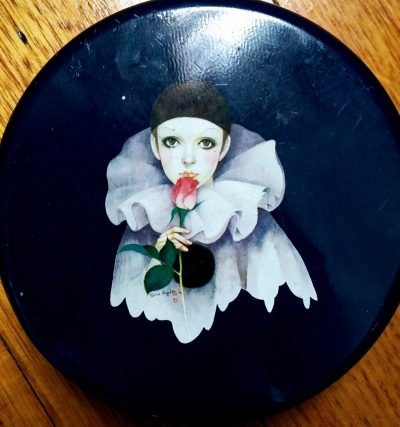
What is the Commedia dell’Arte?
I can’t remember a time when I didn’t know about Harlequin, Columbine and Pierrot so it always comes as a surprise to me when people look blank when I say ‘Harlequin’s Riddle is about the Commedia dell’Arte’. I’m not clear when I first became aware of these wonderful characters, but it was probably when my great-aunt gave me a tin with Pierrot on the lid. Inside was a facewasher and two soaps, also with different Pierrot images. Anyone who grew up in the 70s is probably very familiar with the classic images by Mira Fujita. The Pierrot in them is feminised, the face expressive. These designs were everywhere: on posters, on toiletries, on notebook covers. And Pierrot is the perfect icon for teenage girls – too sensitive for the world, and always yearning for something just out of reach (the beautiful Columbine).
Fujita’s images may be the reason that Pierrot is the most remembered of the Commedia characters today, but in fact he was a late addition to the line-up, and a minor character usually played by the youngest son, since player troupes were often families. Harlequin too has survived, perhaps because tricksters have enormous appeal – just look at the current wave of interest in Loki in the Avengers movies. Other characters are less well known now. But in their time they were adored by the public for whom they performed.
The Commedia dell’Arte is essentially improvised theatre that was usually performed in public spaces, in contrast to the Commedia Erudita, which was scripted and performed on private indoor stages. It appeared in Italy in the mid to late 1500s and its features, including slapstick humour and music, probably developed in order to compete with the noise of the marketplace. Those who look at the history of the Commedia suggest it grew from the antics of charlatans trying to sell their wares through any means possible.
Although Commedia performances were improvised, they had a clear framework from which performances grew. There  were core characters, including the old men, Pantalone and Il Dottore, the lovers, the servants (known as zanni), Il Capitano (the Captain) and Columbina. Then there were secondary characters such as Pulcinella (later Pierrot), Scaramuccia and others. Harlequin, or Arlecchino as he was originally known, was one of the servants.
were core characters, including the old men, Pantalone and Il Dottore, the lovers, the servants (known as zanni), Il Capitano (the Captain) and Columbina. Then there were secondary characters such as Pulcinella (later Pierrot), Scaramuccia and others. Harlequin, or Arlecchino as he was originally known, was one of the servants.
Each character was distinguished by a particular costume, status, posture and walk and particularly by their mask. This meant that when they appeared on stage the audience knew immediately who they were, and the function they would serve in the story. There were also set scenarios, or outlines of the events to be performed. Then, within the scenes, characters had set passages that they might recite, a repertoire of sight-gags the audience would expect from them, and particular ways of interacting with other characters. This means the improvisation actually occurred within very specific boundaries. Much as Hollywood movies now follow certain tropes and patterns, Commedia audiences expected to see familiar characters, events and actions.
As with any popular form of entertainment, Commedia has changed over the centuries since its birth. Whilst there are still troupes today who try to maintain its original framework and characters, its influence can be seen in Punch and Judy shows, Cirque de Soleil and even musical theatre, which grew from the Commedia-like vaudeville performances of the early 20th Century. And, even removed from their Commedia roots, characters like Harlequin, the trickster, Pierrot, the sensitive, and Columbina, the unattainable beauty, still resonate with modern sensibilities. For me, these enduring characters, and the magic that can emerge from improvised theatre, sparked my imagination, offering a world of possibilities that I explore in Harlequin’s Riddle.